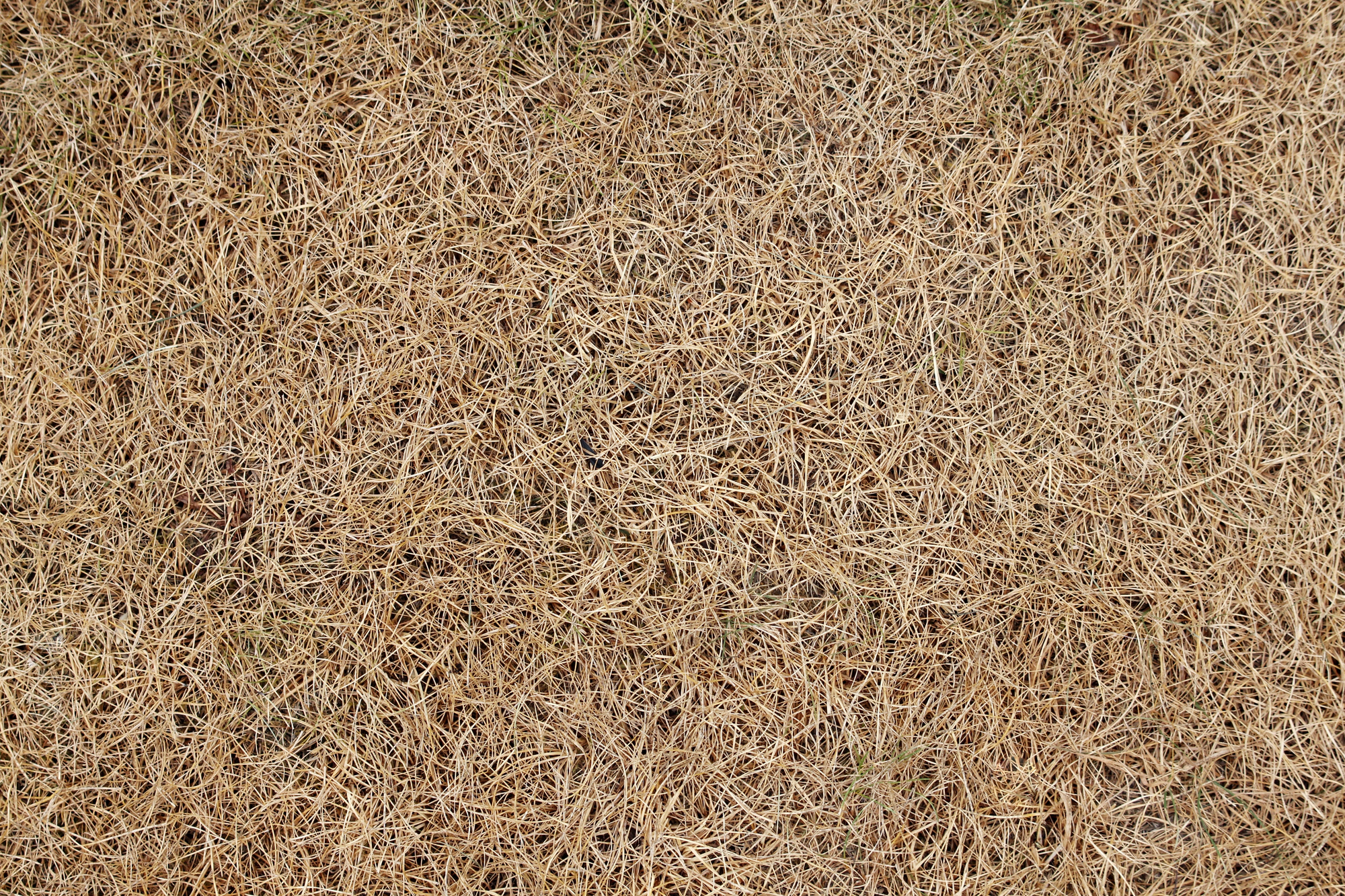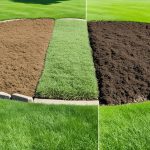As summer temperatures rise, many homeowners notice their once-lush lawns turning brown and brittle. This common phenomenon is known as heat stress, a condition that affects grass when temperatures climb too high. Heat stress occurs when grass plants cannot take up enough water to compensate for moisture lost through their leaves, causing them to wilt, discolour, and potentially die if the situation isn’t addressed.
Heat stress doesn’t affect all lawns equally. Factors such as grass type, soil conditions, and watering practices all influence how well your lawn can withstand hot weather. Newly established lawns are particularly vulnerable, as are those growing in compacted soil or areas with poor drainage.
Key Takeaways
- Heat stress occurs when grass cannot absorb enough water to offset moisture lost during hot weather periods.
- Signs of heat stress include browning, wilting, and footprints remaining visible on the lawn after walking across it.
- Regular deep watering in early morning, raising mowing height, and reducing foot traffic help lawns recover from heat stress.
Understanding Heat Stress in Lawns
Heat stress can severely damage lawns during hot weather, affecting grass health and appearance. Recognising the signs early and understanding how extreme heat impacts your lawn are essential for effective treatment and prevention.
What Is Heat Stress?
Heat stress occurs when grass plants are exposed to temperatures that exceed their tolerance levels for extended periods. This typically happens when temperatures rise above 30°C, especially when combined with low rainfall and high humidity.
The condition develops when grass plants cannot take up enough water to replace what they lose through transpiration. Different grass types have varying heat tolerances. Cool-season grasses like fescue and ryegrass begin to struggle at lower temperatures than warm-season varieties such as Bermuda or zoysia grass.
Environmental factors can worsen heat stress, including:
- Poor soil conditions
- Inadequate irrigation
- Excessive foot traffic
- Reflected heat from pavements
- South-facing slopes with direct sun exposure
How Heat Stress Affects Lawn Health
Heat stress disrupts normal plant functions in several ways. Photosynthesis slows significantly as grass conserves energy, reducing growth and recovery from damage. Root development becomes restricted, limiting the plant’s ability to access water and nutrients deep in the soil.
The protective waxy cuticle on grass blades may break down under extreme heat, increasing water loss. This creates a harmful cycle where the grass becomes increasingly dehydrated and less able to cool itself through transpiration.
Soil microorganisms beneficial to lawn health may become less active or die off during hot periods. This further reduces nutrient availability and breakdown of organic matter. Heat-stressed lawns also become more susceptible to disease, insect damage, and weed invasion as their natural defences weaken.
Symptoms and Signs of Heat Stress
Identifying heat stress early helps prevent permanent damage to your lawn. The first noticeable sign is typically a bluish-grey colour that replaces the healthy green appearance. This colour change indicates the grass is struggling to maintain proper moisture levels.
Footprints or tire tracks remain visible for longer than usual on heat-stressed lawns. This occurs because wilted grass blades lack the rigidity to spring back into position.
Other common symptoms include:
- Wilting despite adequate soil moisture
- Dry, brittle grass blades
- Brown patches developing in sunny areas
- Thinning of previously thick turf
- Compacted soil that repels water rather than absorbing it
During extended hot periods, grass may enter dormancy, turning completely brown as a survival mechanism. While dormant grass appears dead, it can often recover with proper care once temperatures moderate and water becomes available.
Susceptibility of Grass Types and Lawn Conditions
Different grass types vary in their ability to handle heat and drought conditions, with genetic and environmental factors both playing major roles in how lawns respond to hot weather.
Cool-Season Grasses and Heat Sensitivity
Cool-season grasses typically struggle during hot weather, especially when temperatures exceed 30°C. Kentucky bluegrass often shows stress first, with leaves turning blue-grey before browning and entering dormancy. This grass type requires about 2.5-5 cm of water weekly during summer to stay healthy.
Perennial rye shows heat stress through wilting and discolouration, but can recover well with proper irrigation. Fine fescue varieties offer better drought resistance among cool-season types but still suffer in extended heat.
Tall fescue stands out in the cool-season category with deeper root systems (up to 60-90 cm) that access subsurface moisture. This makes it more resilient during hot spells compared to other cool-season varieties.
Areas with compacted soil or poor drainage see amplified heat stress in cool-season lawns, as restricted root growth limits the grass’s ability to find water.
Warm-Season Grasses and Heat Tolerance
Warm-season grasses thrive in hot conditions, with optimal growth occurring between 26-35°C. Bermuda grass excels in heat tolerance with exceptional drought resistance, able to survive extended dry periods by going dormant while quickly greening up after rainfall.
St. Augustine grass handles heat well but needs more moisture than Bermuda. Its broad, coarse leaves provide natural shade to the soil, reducing evaporation and ground temperature. However, it shows stress through leaf curling when water is insufficient.
Centipede grass offers good heat resistance while requiring less maintenance and fertiliser than other warm-season varieties. Zoysia develops extremely deep root systems that can reach water sources unavailable to other grasses.
Heat Stress Signs in Warm-Season Grasses:
- Slowed growth rate
- Thinning patches
- Delayed recovery from traffic damage
- Increased susceptibility to disease
Impact of Grass Varieties and Native Grasses
Within each grass species, specific cultivars show varying degrees of heat tolerance. Newer varieties of Kentucky bluegrass, for instance, have been bred specifically for improved drought resistance while maintaining desirable turf qualities.
Native grasses adapted to local conditions often demonstrate superior heat resilience. These grasses evolved in their specific regions and developed natural mechanisms to handle local climate extremes.
Buffalo grass and other native varieties typically require 30-50% less water than conventional turf options. Their deep root structures access groundwater sources effectively during dry spells.
Mixed lawns combining different grass types can provide better overall heat resistance. For example, combining tall fescue with small amounts of Kentucky bluegrass creates a lawn with both drought tolerance and recovery capabilities.
Lawns established for longer periods (3+ years) generally develop more extensive root systems that improve their ability to withstand heat stress compared to newly planted turf.
Primary Causes and Environmental Factors
Heat stress in lawns develops from several interrelated factors that affect grass health during hot periods. Temperature extremes combined with inadequate moisture and poor soil conditions create the perfect environment for lawn distress.
Drought and Water Stress
Lawns require consistent moisture to maintain cellular functions and cooling mechanisms. When water becomes scarce, grass plants cannot transport nutrients effectively or regulate their temperature through transpiration.
A moisture deficit of just 30% below optimal levels can trigger visible signs of heat stress in most lawn varieties. The first response is typically wilting, where grass blades fold to reduce surface area and water loss.
Soil moisture levels below 30% of field capacity significantly increase the risk of permanent damage. This is why proper irrigation during hot periods is essential, with deep watering of 2.5-4 cm per week being more beneficial than frequent light sprinklings.
Morning watering (between 4-10 am) allows moisture to penetrate before evaporation rates peak. Evening watering may promote fungal growth if water sits on grass blades overnight.
Soil Structure and Drainage
Poor soil composition directly impacts a lawn’s heat tolerance. Heavy clay soils compact easily, restricting root growth and oxygen availability essential for healthy grass.
A soil test can identify structural issues that contribute to heat stress. Ideal lawn soils contain:
- 45-50% mineral content
- 25% water
- 25% air
- 5% organic matter
Compacted soils prevent roots from accessing deeper moisture reserves during hot weather. Root systems restricted to the top 5 cm of soil are far more vulnerable to heat damage than those reaching 15-20 cm deep.
Thatch layers exceeding 1.5 cm thick act as barriers to water penetration and increase surface temperature. Regular aeration and dethatching help improve soil structure and heat resilience.
Role of Extreme Weather and Summer Dormancy
Temperature extremes above 29°C force cool-season grasses like fescues and ryegrass to expend more energy than they can produce through photosynthesis. This energy deficit triggers protective mechanisms.
Summer dormancy is a natural survival response where grass slows growth and may turn brown to conserve resources. This state is different from death and allows recovery when conditions improve.
During periods of extreme heat (35°C+), grass can lose 2-3 times more water than it can absorb through its roots. These conditions create a negative water balance that compounds heat stress.
Many lawn varieties can survive 3-4 weeks in dormancy if left undisturbed. Attempting to force growth during this period with high-nitrogen fertilisers can deplete grass energy reserves and cause permanent damage.
Treatment Methods for Heat-Stressed Lawns
Restoring a heat-stressed lawn requires a combination of proper watering, soil management, and protective measures to help grass recover and build resilience against high temperatures.
Proper Watering Practices
Watering correctly is the first line of defence against heat stress. Apply water deeply but infrequently to encourage deep root growth. Early morning watering (between 4am and 9am) is best as it reduces evaporation and fungal disease risk.
Most lawns need about 2.5-4cm of water per week during hot weather. Use a rain gauge or tuna tin to measure application rates. Water should penetrate 15-20cm into the soil.
Signs of proper watering include:
- No runoff during application
- Soil remains moist but not soggy
- Grass springs back when walked on
Avoid evening watering as wet foliage overnight can lead to disease problems. Reduce frequency but increase duration of each watering session to train roots to grow deeper.
Supplemental Irrigation and Drought Management
During extended hot periods, supplemental irrigation becomes essential for lawn survival. Consider installing a smart irrigation system that adjusts based on weather conditions and soil moisture levels.
For manual watering, soaker hoses or drip irrigation systems deliver water directly to soil with minimal waste. These systems can reduce water usage by up to 70% compared to sprinklers.
When water restrictions are in place, focus on keeping the crown of the grass plants alive. Apply just enough water to prevent dormancy from becoming death—typically about 1.5cm every two weeks.
A simple drought management plan includes:
- Identifying priority areas for watering
- Raising mowing height to 7-10cm
- Limiting foot traffic on stressed areas
- Accepting some temporary browning
Soil Improvement and Aeration
Poor soil structure significantly worsens heat stress. Core aeration—removing small plugs of soil—alleviates compaction and allows water, air and nutrients to reach grass roots.
The best times for aeration are spring and autumn when grass is actively growing. For severely compacted lawns, aerate twice yearly.
A soil test can identify specific deficiencies affecting your lawn’s heat tolerance. Most lawn centres offer testing services that provide tailored recommendations for amendments.
Adding organic matter improves soil structure and water retention. Top-dress with 1cm of compost after aeration, working it into holes with a rake or brush.
Clay soils benefit from gypsum application to improve structure, while sandy soils need organic matter to increase water-holding capacity.
Mulching and Surface Protection
Grass clippings serve as natural mulch when left on the lawn after mowing. These clippings shade soil, reduce evaporation, and return nutrients to the grass.
For best results, use a mulching mower that cuts clippings finely and distributes them evenly. Clippings should be short enough to filter down to soil level rather than sitting on top of the grass.
In severe heat, temporary shading of the most vulnerable areas can prevent damage. Use shade cloth with 30-50% light transmission, suspended above the grass to allow air circulation.
Other surface protection methods include:
- Applying a light layer of fine compost (3mm)
- Using natural wetting agents to improve water penetration
- Reducing reflection from walls and paved areas with plants or screens
- Limiting activities on heat-stressed areas until recovery occurs
Prevention and Long-Term Lawn Health
Preventing heat stress in lawns requires proper planning and consistent maintenance throughout the year. A combination of appropriate grass selection, thoughtful watering practices and disease management can significantly reduce the risk of heat damage.
Selecting the Right Grass and Clover Integration
Choosing heat-tolerant grass varieties is essential for preventing summer stress. Warm-season grasses like Bermuda, Zoysia and Buffalo grass withstand high temperatures better than cool-season varieties. In the UK, look for drought-resistant fescue mixes specifically bred for local conditions.
Integrating clover into your lawn offers multiple benefits during hot periods:
- White clover stays green in drought conditions
- Fixes nitrogen naturally, reducing fertiliser needs
- Creates deeper root systems that access water lower in soil
- Provides cooling ground cover that shades soil
When establishing a new lawn, consider a mixed seed approach with both grass and 5-10% clover. This combination creates a more resilient system that handles temperature extremes with less stress.
Seasonal Lawn Care Strategies
Spring preparation lays the groundwork for summer heat resistance. Aerate your lawn in early spring to improve water penetration and root development. Apply a light organic fertiliser to strengthen grass before summer stress begins.
During summer months, adjust your maintenance routine:
- Mow higher (7-8 cm) to promote deeper roots and soil shading
- Water deeply but infrequently (2-3 times weekly) in early morning
- Reduce foot traffic on stressed areas
- Consider applying seaweed extract as a natural stress reliever
Autumn recovery is equally important. Overseed thin patches, apply compost top-dressing, and continue proper watering until consistent rainfall returns. This helps healthy grass recover from summer damage and prepares it for the following year.
Disease Prevention and Fungal Issues
Heat stress weakens lawn defences, making grass more susceptible to fungal disease. Brown patch, red thread and rust commonly affect heat-stressed lawns, appearing as circular dead patches or discoloured blades.
Early identification is critical. Check for:
- Irregular brown patches that expand daily
- White/grey mycelium visible in morning dew
- Orange or red spots on grass blades
Prevention strategies include improving air circulation by removing excess thatch and avoiding evening watering. When applying fertiliser, use balanced formulations with appropriate nitrogen levels – excessive nitrogen promotes fungal growth in warm weather.
For natural fungal control, consider neem oil applications or compost tea sprays that introduce beneficial microorganisms. Chemical fungicides should be a last resort when disease threatens large lawn areas.





